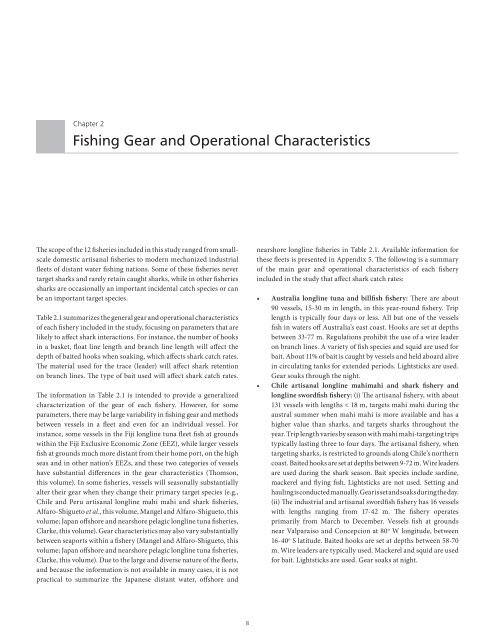Shark Depredation and Unwanted Bycatch in Pelagic Longline
Shark Depredation and Unwanted Bycatch in Pelagic Longline
Shark Depredation and Unwanted Bycatch in Pelagic Longline
You also want an ePaper? Increase the reach of your titles
YUMPU automatically turns print PDFs into web optimized ePapers that Google loves.
Chapter 2<br />
Fish<strong>in</strong>g Gear <strong>and</strong> Operational Characteristics<br />
The scope of the 12 fisheries <strong>in</strong>cluded <strong>in</strong> this study ranged from smallscale<br />
domestic artisanal fisheries to modern mechanized <strong>in</strong>dustrial<br />
fleets of distant water fish<strong>in</strong>g nations. Some of these fisheries never<br />
target sharks <strong>and</strong> rarely reta<strong>in</strong> caught sharks, while <strong>in</strong> other fisheries<br />
sharks are occasionally an important <strong>in</strong>cidental catch species or can<br />
be an important target species.<br />
Table 2.1 summarizes the general gear <strong>and</strong> operational characteristics<br />
of each fishery <strong>in</strong>cluded <strong>in</strong> the study, focus<strong>in</strong>g on parameters that are<br />
likely to affect shark <strong>in</strong>teractions. For <strong>in</strong>stance, the number of hooks<br />
<strong>in</strong> a basket, float l<strong>in</strong>e length <strong>and</strong> branch l<strong>in</strong>e length will affect the<br />
depth of baited hooks when soak<strong>in</strong>g, which affects shark catch rates.<br />
The material used for the trace (leader) will affect shark retention<br />
on branch l<strong>in</strong>es. The type of bait used will affect shark catch rates.<br />
The <strong>in</strong>formation <strong>in</strong> Table 2.1 is <strong>in</strong>tended to provide a generalized<br />
characterization of the gear of each fishery. However, for some<br />
parameters, there may be large variability <strong>in</strong> fish<strong>in</strong>g gear <strong>and</strong> methods<br />
between vessels <strong>in</strong> a fleet <strong>and</strong> even for an <strong>in</strong>dividual vessel. For<br />
<strong>in</strong>stance, some vessels <strong>in</strong> the Fiji longl<strong>in</strong>e tuna fleet fish at grounds<br />
with<strong>in</strong> the Fiji Exclusive Economic Zone (EEZ), while larger vessels<br />
fish at grounds much more distant from their home port, on the high<br />
seas <strong>and</strong> <strong>in</strong> other nation’s EEZs, <strong>and</strong> these two categories of vessels<br />
have substantial differences <strong>in</strong> the gear characteristics (Thomson,<br />
this volume). In some fisheries, vessels will seasonally substantially<br />
alter their gear when they change their primary target species (e.g.,<br />
Chile <strong>and</strong> Peru artisanal longl<strong>in</strong>e mahi mahi <strong>and</strong> shark fisheries,<br />
Alfaro-Shigueto et al., this volume, Mangel <strong>and</strong> Alfaro-Shigueto, this<br />
volume; Japan offshore <strong>and</strong> nearshore pelagic longl<strong>in</strong>e tuna fisheries,<br />
Clarke, this volume). Gear characteristics may also vary substantially<br />
between seaports with<strong>in</strong> a fishery (Mangel <strong>and</strong> Alfaro-Shigueto, this<br />
volume; Japan offshore <strong>and</strong> nearshore pelagic longl<strong>in</strong>e tuna fisheries,<br />
Clarke, this volume). Due to the large <strong>and</strong> diverse nature of the fleets,<br />
<strong>and</strong> because the <strong>in</strong>formation is not available <strong>in</strong> many cases, it is not<br />
practical to summarize the Japanese distant water, offshore <strong>and</strong><br />
nearshore longl<strong>in</strong>e fisheries <strong>in</strong> Table 2.1. Available <strong>in</strong>formation for<br />
these fleets is presented <strong>in</strong> Appendix 5. The follow<strong>in</strong>g is a summary<br />
of the ma<strong>in</strong> gear <strong>and</strong> operational characteristics of each fishery<br />
<strong>in</strong>cluded <strong>in</strong> the study that affect shark catch rates:<br />
• Australia longl<strong>in</strong>e tuna <strong>and</strong> billfish fishery: There are about<br />
90 vessels, 15-30 m <strong>in</strong> length, <strong>in</strong> this year-round fishery. Trip<br />
length is typically four days or less. All but one of the vessels<br />
fish <strong>in</strong> waters off Australia’s east coast. Hooks are set at depths<br />
between 33-77 m. Regulations prohibit the use of a wire leader<br />
on branch l<strong>in</strong>es. A variety of fish species <strong>and</strong> squid are used for<br />
bait. About 11% of bait is caught by vessels <strong>and</strong> held aboard alive<br />
<strong>in</strong> circulat<strong>in</strong>g tanks for extended periods. Lightsticks are used.<br />
Gear soaks through the night.<br />
• Chile artisanal longl<strong>in</strong>e mahimahi <strong>and</strong> shark fishery <strong>and</strong><br />
longl<strong>in</strong>e swordfish fishery: (i) The artisanal fishery, with about<br />
131 vessels with lengths < 18 m, targets mahi mahi dur<strong>in</strong>g the<br />
austral summer when mahi mahi is more available <strong>and</strong> has a<br />
higher value than sharks, <strong>and</strong> targets sharks throughout the<br />
year. Trip length varies by season with mahi mahi-target<strong>in</strong>g trips<br />
typically last<strong>in</strong>g three to four days. The artisanal fishery, when<br />
target<strong>in</strong>g sharks, is restricted to grounds along Chile’s northern<br />
coast. Baited hooks are set at depths between 9-72 m. Wire leaders<br />
are used dur<strong>in</strong>g the shark season. Bait species <strong>in</strong>clude sard<strong>in</strong>e,<br />
mackerel <strong>and</strong> fly<strong>in</strong>g fish. Lightsticks are not used. Sett<strong>in</strong>g <strong>and</strong><br />
haul<strong>in</strong>g is conducted manually. Gear is set <strong>and</strong> soaks dur<strong>in</strong>g the day.<br />
(ii) The <strong>in</strong>dustrial <strong>and</strong> artisanal swordfish fishery has 16 vessels<br />
with lengths rang<strong>in</strong>g from 17-42 m. The fishery operates<br />
primarily from March to December. Vessels fish at grounds<br />
near Valparaiso <strong>and</strong> Concepcion at 80 o W longitude, between<br />
16-40 o S latitude. Baited hooks are set at depths between 58-70<br />
m. Wire leaders are typically used. Mackerel <strong>and</strong> squid are used<br />
for bait. Lightsticks are used. Gear soaks at night.












